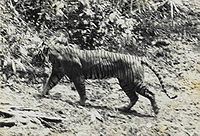
Photo from wikipedia
Background Trichoptera are one of the most diverse groups of freshwater insects worldwide and one of the main bioindicators for freshwater quality. However, in many areas, caddisflies remain understudied due… Click to show full abstract
Background Trichoptera are one of the most diverse groups of freshwater insects worldwide and one of the main bioindicators for freshwater quality. However, in many areas, caddisflies remain understudied due to lack of taxonomic expertise. Meanwhile, globally increasing anthropogenic stress on freshwater streams also threatens Trichoptera diversity. Methods To assess the Trichoptera diversity of the area within and around the Mount Halimun Salak National Park (MHSNP or Taman Nasional Gunung Halimun Salak) in West Java (Indonesia), we conducted a molecular-morphological study on Trichoptera diversity using larvae from a benthic survey and adults from hand-netting. In addition to morphological identification, we applied four different molecular taxon delimitation approaches (Generalized Mixed Yule Coalescent, Bayesian Poisson Tree Processes, Automatic Barcode Gap Discovery and Assemble Species by Automatic Partitioning) based on DNA barcoding of Cytochrome-C-Oxidase I (COI). Results The molecular delimitation detected 72 to 81 Operational Taxonomic Units (OTU). Only five OTUs could be identified to species level by comparing sequences against the BOLD database using BLAST, and four more to the genus level. Adults and larvae could be successfully associated in 18 cases across six families. The high diversity of Trichoptera in this area highlights their potential as bioindicators for water quality assessment. Conclusions This study provides an example of how molecular approaches can benefit the exploration of hidden diversity in unexplored areas and can be a valuable tool to link life stages. However, our study also highlights the need to improve DNA barcode reference libraries of Trichoptera for the Oriental region.
Journal Title: PeerJ
Year Published: 2022
Link to full text (if available)
Share on Social Media: Sign Up to like & get
recommendations!